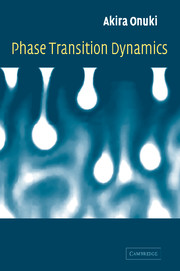Preface
Published online by Cambridge University Press: 13 August 2009
Summary
This book aims to elucidate the current status of research in phase transition dynamics. Because the topics treated are very wide, a unified phenomenological time-dependent Ginzburg–Landau approach is used, and applied to dynamics near the critical point. Into the simple Ginzburg–Landau theory for a certain order parameter, we introduce a new property or situation such as elasticity in solids, viscoelasticity in polymers, shear flow in fluids, or heat flow in He near the superfluid transition. By doing so, we encounter a rich class of problems on mesoscopic spatial scales. A merit of this approach is that we can understand such diverse problems in depth using universal concepts.
The first four chapters (Part one) deal with static situations, mainly of critical phenomena, and introduce some new results that would stand by themselves. However, the main purpose of Part one is to present the definitions of many fundamental quantities and introduce various phase transitions. So it should be read before Parts two and three which deal with dynamic situations. Chapter 5 is also introductory, reviewing fundamental dynamic theories, the scheme of Langevin equations and the linear response theory. Chapter 6 treats critical dynamics in (i) classical fluids near the gas–liquid and consolute critical points and (ii) He near the superfluid transition. Chapter 7 focuses on rather special problems in complex fluids: (i) effects of viscoelasticity on composition fluctuations in polymer systems; and (ii) volume phase transitions and heterogeneity effects in gels.
- Type
- Chapter
- Information
- Phase Transition Dynamics , pp. ix - xPublisher: Cambridge University PressPrint publication year: 2002

